Multiple Authors
04.08.2022 | 4:30pmIn the early 2000s, a new field of climate-science research emerged that began to explore the human fingerprint on extreme weather, such as floods, heatwaves, droughts and storms.
Known as “extreme event attribution”, the field has gained momentum, not only in the science world, but also in the media and public imagination. These studies have the power to link the seemingly abstract concept of climate change with personal and tangible experiences of the weather.
Scientists have published more than 400 peer-reviewed studies looking at weather extremes around the world, from wildfires in the US and heatwaves in India and Pakistan to typhoons in Asia and record-breaking rainfall in the UK. The result is mounting evidence that human activity is raising the risk of some types of extreme weather, especially those linked to heat.
To track how the evidence on this fast-moving topic is stacking up, Carbon Brief has mapped – to the best of our knowledge – every extreme-weather attribution study published to date.
Carbon Brief’s analysis reveals:
- 71% of the 504 extreme weather events and trends included in the map were found to be made more likely or more severe by human-caused climate change.
- 9% of events or trends were made less likely or less severe by climate change, meaning 80% of all events experienced some human impact. The remaining 20% of events and trends showed no discernible human influence or were inconclusive.
- Of the 152 extreme heat events that have been assessed by scientists, 93% found that climate change made the event or trend more likely or more severe.
- For the 126 rainfall or flooding events studied, 56% found human activity had made the event more likely or more severe. For the 81 drought events studied, it’s 68%.
First published in July 2017, this article is the fifth annual update (see endnote) to incorporate new studies. The aim is that it serves as a tracker for the evolving field of “extreme event attribution”.
Using the map
The map above shows 504 extreme weather events and trends across the globe for which scientists have carried out attribution studies. The different symbols show the type of extreme weather; for example, a heatwave, flood or drought. The colours indicate whether the attribution study found a link to human-caused climate change (red), no link (blue) or was inconclusive (grey).
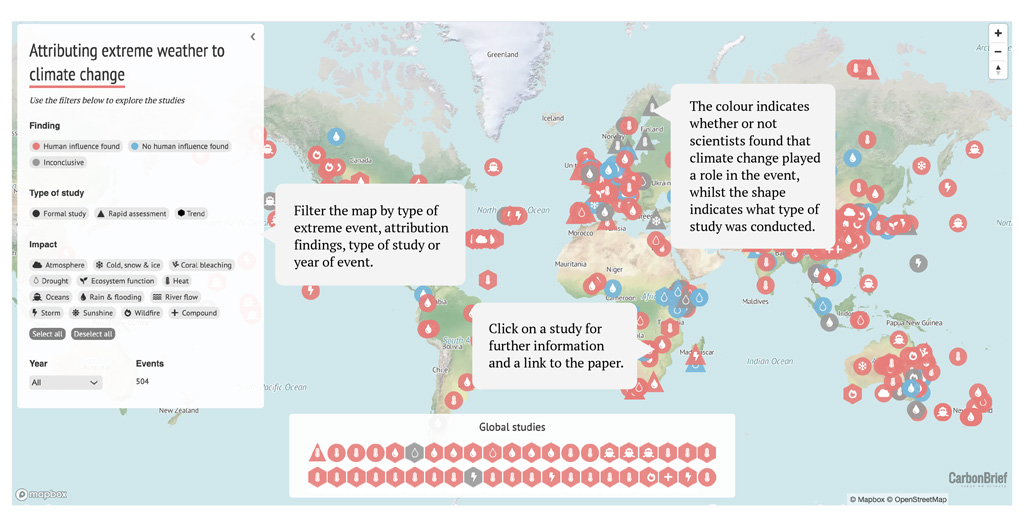
Use the plus and minus buttons in the top-left corner, or double click anywhere, to zoom in on any part of the world. Click on a symbol to reveal more information, including a quote from the original paper to summarise the findings and a link to the online version.
The filter on the left allows users to select a specific type of weather event to look at or, for example, only those found to be influenced by climate change.
The filter can also be used to highlight extreme events from a particular year. (Note: earlier versions of this map classified events by the year that the study or analysis was published.) To isolate studies that assess the changing trends of weather extremes, click the “trend” box in the filter.
The software used to make the map currently only works with a Web Mercator projection (as used by virtually all major online map providers). It is worth noting that this – like all map projections – offers a somewhat distorted view of the world.
It is important to note that the weather events scientists have studied so far are not randomly chosen. They can be high-profile events, such as Hurricane Harvey, or simply the events that occurred nearest to scientific research centres. (More on this below.)
The map includes three different types of studies. The circles and hexagons on the map indicate papers published in peer-reviewed journals. The different shapes refer to whether the study considers an individual extreme event (circles), such as a wildfire or storm, or whether it analyses longer-term trends in extreme weather (hexagons), such as the change in frequency of flooding or marine heatwaves over time.
The third shape – triangles – indicate rapid attribution studies. These are quickfire assessments of the climate change contribution to extreme weather events, published online shortly after an event concludes. (More on this below.)
Finally, it is worth noting that some of the icon locations are approximate – particularly for studies that cover large regions. For example, global studies can be found grouped together in the middle of the Atlantic Ocean.
Extreme weather types
The events and trends shown on the map are covered by 431 individual scientific papers or rapid studies. Where a single study covers multiple events or locations, these have been separated out into individual entries on the map.
Combining the evidence over the past 20 years, the literature is heavily dominated by studies of extreme heat (30%), rainfall or flooding (25%) and drought (16%). Together, these make up more than two-thirds of all published studies (71%). The full list is available in this Google sheet.
As the chart below shows, the number of extreme events studied has grown substantially over the past 10-15 years. Note that formal studies typically follow a year or so after the event itself as the writing and peer-review process for journal papers can take many months.
The majority of studies included here have been published in the annual “Explaining extreme events” special issues of the Bulletin of the American Meteorological Society (BAMS). Each bumper volume typically contains around 15-30 peer-reviewed studies of events from the previous year. Other studies have been found through the Climate Signals database and online searches through journals. This update includes studies published up to the end of May 2022.
(Note: The map currently only includes studies published in English.)
Specific types of event can be displayed in the chart below by clicking on the category names at the top.
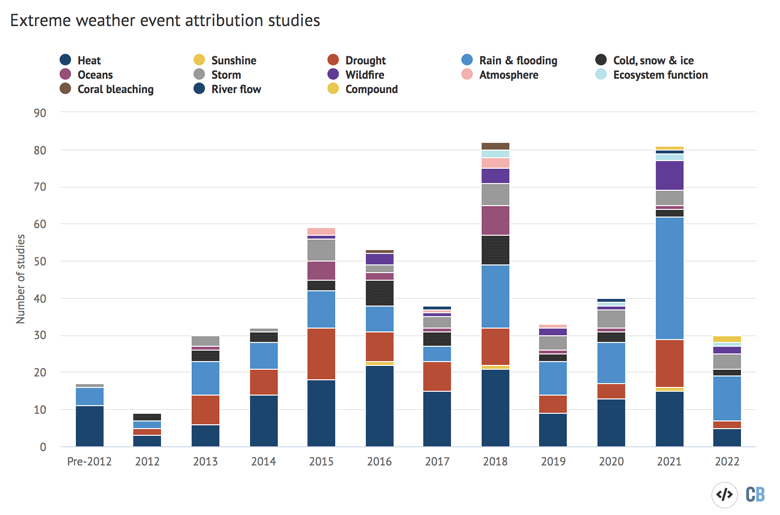
Most of the categories of extreme weather are self-explanatory, but “storms” and “oceans” require a bit of explanation.
For ease of presentation, the “storms” category includes both tropical cyclones – such as hurricanes and typhoons – and extratropical storms. The “oceans” category encompasses studies looking at marine heatwaves, storm surges and the strength of El Niño events.
Newer categories include “coral bleaching” and “ecosystem services”, reflecting the ongoing developments in attribution science. For example, a rapid attribution study concluded that climate change had “drastically” increased the likelihood of the conditions leading to bleaching of the Great Barrier Reef in 2016 – by at least 175 times. And a 2022 study found that “extremely early” cherry-tree flowering in Kyoto in March 2021 was made “15 times more likely” by climate change.
For this latest iteration of the map, a new category of “compound” extreme events has also been added. This includes, for example, a 2021 study that found climate change had contributed to the “high likelihood” of combined dry and hot events in recent decades over most of China.
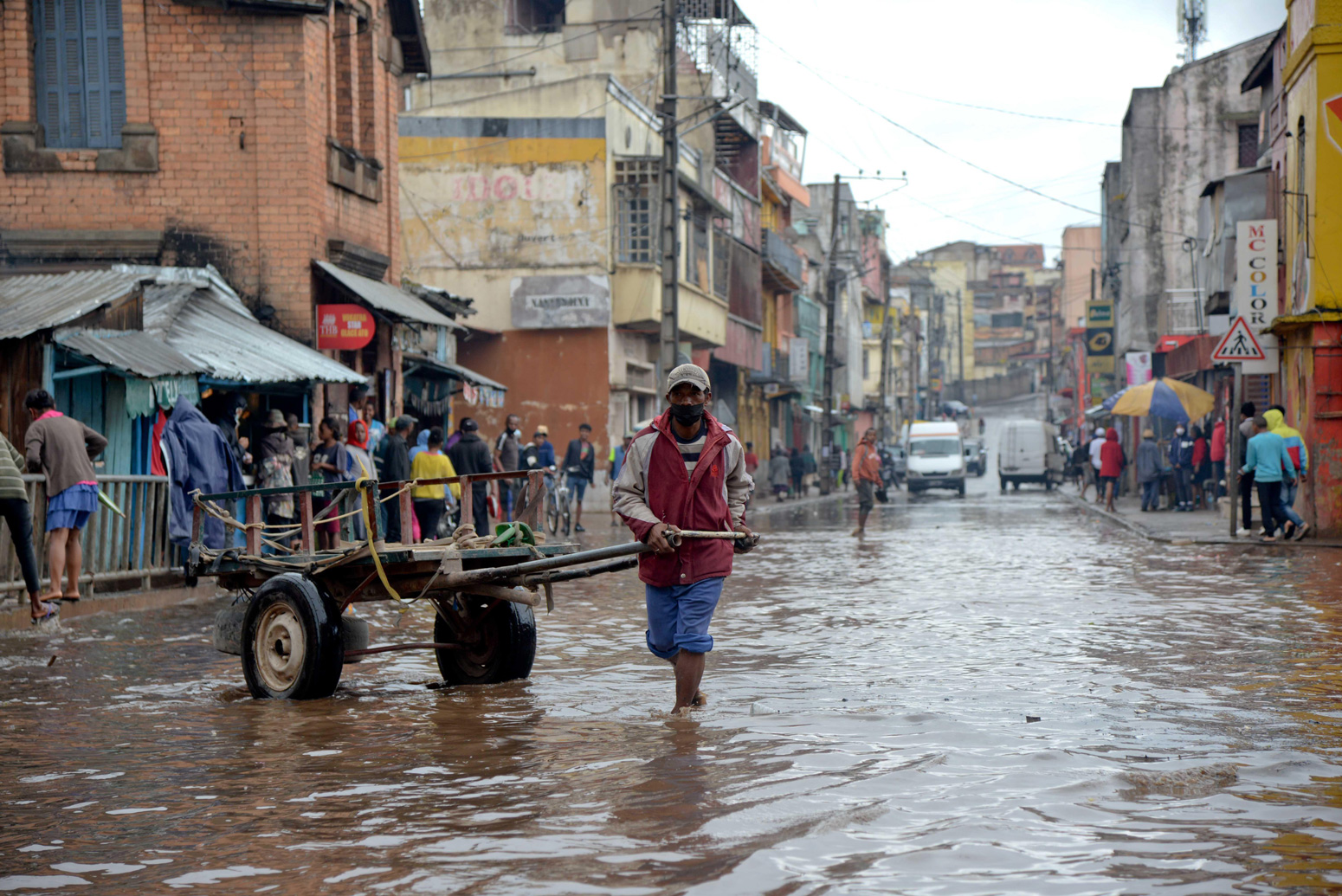
Such studies show that attribution studies are increasingly considering the impacts of extremes, rather than focusing purely on the weather event.
One of the first of these “impact attribution” studies was published in 2016. It estimated that 506 of the 735 fatalities in Paris during the 2003 European heatwave were down to the fact that climate change had made the heat more intense than it would otherwise have been. The same was true for 64 of the 315 fatalities in London, the study said. Health impacts have increasingly become a focus of attribution studies.
Similarly, a 2021 study found that 37% of “warm-season heat-related deaths” across 43 countries between 1991 and 2018 “can be attributed to anthropogenic climate change and that increased mortality is evident on every continent”. Another 2021 study, which the authors unpacked in a Carbon Brief guest post, found that climate change was a “critical driver” of the drought that led to a food crisis in Lesotho in 2007. And a third 2021 study – also the subject of a Carbon Brief guest post – on the rising threat of an “outburst flood” from glacial lakes in the Peruvian Andes found that the retreat of the region’s glaciers was “entirely attributable” to human-caused warming.
This shift towards impacts “is quite significant”, says Prof Peter Stott, who leads the climate monitoring and attribution team at the Met Office Hadley Centre and has been a co-editor of the BAMS reports since they began in 2012. He tells Carbon Brief:
“Impacts are hard to do because you have to establish a significant link between the meteorology and the impact in question. As editors, we’ve been trying to encourage more studies on impacts because it’s the impacts rather than the meteorology per se that tends to motivate these types of study – and if we only have the attribution on the meteorological event then we only have an indirect link to the relevant impact.”
Attribution of climate impacts could even be used in the courts, one 2021 study explained. The authors wrote a Carbon Brief guest post explaining how attribution science can be “translated into legal causality”. They wrote:
“Attribution can bridge the gap identified by judges between a general understanding that human-induced climate change has many negative impacts and providing concrete evidence of the role of climate change at a specific location for a specific extreme event that already has led or will lead to damages.”
Finally, attribution research has also identified the “signal” of human influence in other indicators of climate change, such as increasing average temperature, rising lake temperatures or sea level rise. Recent research has even been able to detect the fingerprint of climate change “from any single day in the observed global record since early 2012, and since 1999 on the basis of a year of data”. These types of studies have not been included in the attribution map as the focus here is on extremes.
Human influence on extreme weather
Of the attribution studies included here, scientists found that human-caused climate change has altered the likelihood or severity of an extreme weather event in 80% of cases studied (71% made more severe or likely and 9% made less so).
In Carbon Brief’s first edition of this analysis in 2017, 68% of events were found to have a human impact (with 63% made more severe or likely and 6% less so).
While these figures are not representative of all extreme weather events – attribution studies have only been conducted on a relatively small number – previous research has taken this broader view. For example, a 2015 study estimated the fraction of all globally occurring heat and heavy rainfall extremes that was attributable to warming. The authors found that around 75% of “moderate daily hot extremes over land” and 18% of “moderate daily precipitation extremes over land” were attributable to the observed temperature increase since pre-industrial times. These fractions are expected to increase with further warming, the authors noted.
There are several ways of carrying out an attribution analysis. (A team of attribution scientists wrote a Carbon Brief guest post in 2021 that unpacks their methods.) One of the most common is to take observations and/or climate model simulations of an extreme event in the current climate and compare them with idealised model runs of that event in a world without human-caused global warming. The difference between the “with” and “without” climate change simulations indicates how the likelihood or severity of that extreme event has changed.
Note that events are classified here as having an human impact if climate change is found to have influenced at least one aspect of that event. For example, a study of the 2011 East Africa drought found that climate change contributed to the failure of the “long rains” in early 2011, but that the lack of “short rains” in late 2010 was down to the climate phenomenon La Niña. This event is, thus, designated as having a human impact.
For the majority of events affected by climate change, the balance has shifted in the same direction. That is, rising temperatures made the event in question more severe or more likely to occur. These events are represented by the red in the chart below. Clicking on the red “slice” reveals that heatwaves account for 40% of such events, rainfall or flooding for 20%, and droughts for 15%. Return to the original chart, and do the same with the other slices to see the proportion of different weather types in each category.
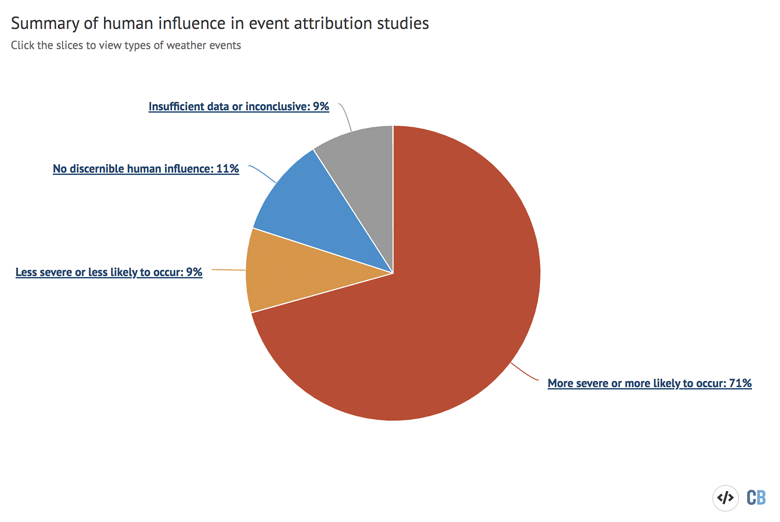
In 11% of extreme weather events and trends studied, scientists found no discernible influence from human activity. These are coloured blue in the map and the chart above. For a further 9%, the observational data or modelling techniques used in the study were insufficient to reach a reliable conclusion (shown as grey in the map and pie chart).
In 9% of studied weather events and trends, scientists found climate change had made the event less likely or less severe (pale orange in the chart above).
Unsurprisingly, this category includes blizzards and extreme cold snaps. However, it also features a few studies that suggest climate change has lessened the chances of heavy rainfall, and another that found rising temperatures have made agricultural drought in California less likely.
Drought is complicated (more on this below). Briefly, though, it is worth noting that five other studies looking at different aspects of the California drought over 2011-17 found climate change had played a role. Two found no discernible link (pdf, p7-15), while one was inconclusive (pdf, p3).
Interestingly, a 2020 study analysed the way links between climate change and the California drought were portrayed in US media. It finds that the links were “covered widely in both local and national news”, but notes:
“However, legitimate differences in the methods underpinning the attribution studies performed by different researchers often resulted in a frame of scientific uncertainty or disagreement in the media coverage.”
As the case of California’s drought shows, it is often necessary to dig deeper to understand the full picture. The rest of this article looks at the evidence for the three most-studied types of extreme weather – heatwaves, heavy rain and floods, and droughts – as well as some of the main issues in event attribution, and where the field as a whole is heading.
Heatwaves
The attribution map includes studies of 152 extreme heat events, of which 142 (93%) have been made more likely or more severe because of climate change. No studies have found a heatwave that has been made less severe by climate change, while studies of two events (1%) identified no influence and a further eight (5%) were inconclusive.
In recent years, studies have shown that several heat extremes would have been impossible or virtually impossible without human influence on the climate. These include Siberia’s heatwave of 2020, the Pacific north-west “heat dome” event of 2021 and Europe’s record-breaking summer of 2021.

The studies on extreme heat that did not find a role for climate change were an analysis of the Russian heatwave in 2010 and a rapid attribution study of the all-time high temperatures recorded in Rajasthan, India in May 2016. For the latter, the authors suggested that “the lack of a detectable trend may be due to the masking effect of aerosols on global warming and increased use of irrigation”.
While heatwaves are the most-studied extreme event in attribution literature, they are becoming “less and less interesting for researchers”, notes a Bloomberg article from 2020. Dr Friederike Otto is a senior lecturer at the Grantham Institute for Climate Change and the Environment at Imperial College London and co-leader of World Weather Attribution, a consortium of scientific organisations founded in 2014 to deliver “timely and scientifically reliable information on how extreme weather may be affected by climate change”. She told Bloomberg that the consortium chose not to investigate California’s record-breaking summer 2020 heatwave as “the evidence is so strong already”.
A particularly well-studied region for heatwaves in the literature is Australia, which accounts for 10% of the heat-related events included here. And climate change was found to play a role in all but one of the 15 Australian heat events studied. It is worth noting for that one event, however, that although the study (pdf, p145) was inconclusive for the city of Melbourne in south-east Australia, the authors did detect a human influence on extreme heat up the coast in Adelaide.
This raises a few important points. First, finding that climate change contributed to an event is not the same as saying it “caused” that event. Attribution is about working out if the likelihood or magnitude of a particular event happening now is different from what it would be in a world that was not warming.
A useful analogy – as explained in the first BAMS report in 2012 – is of a baseball player who starts taking steroids. If the player begins hitting 20% more home runs than before, it would not be possible to say for sure whether a particular home run is because of the steroids or the player’s spontaneous skill. But it is possible to say how the steroids have altered the likelihood that the player hits a home run, by comparing their current and historical performances. As the report put it:
“Given that steroids have resulted in a 20% increased chance that any particular swing of the player’s bat results in a home run, you would be able to make an attribution statement that, all other things being equal, steroid use had increased the probability of that particular occurrence by 20%.”
Another important point is that in cases where attribution science finds that climate change is making a given type of extreme weather more likely, it does not necessarily follow that the chance of experiencing that kind of weather gets incrementally higher each year. Natural variability means that there will still be ups and downs in the strength and frequency of extreme events.
Finally, there is usually a level of confidence attached to attribution results. So, while two studies might both find a role for human influence in a given weather event, the signal may be stronger for one than the other. For the purposes of this analysis, the attribution map does not distinguish between high- and low-confidence results, but users can click through to each study for more details.
Heavy rain and flooding
Of the 126 rainfall or flooding events included in the attribution map, 71 (56%) found human activity had made the event more likely or more severe – a far smaller proportion than for heat-related studies. Nineteen studies (15%) found that climate change had made the whole event less likely to occur. Of the remaining heavy rainfall events, studies of 24 (19%) found no evidence of a link to climate change, while 12 (10%) were inconclusive.
That there is a more divided set of results for extreme rainfall than for heatwaves could suggest several things. In some cases, limited data might make it difficult to detect a clear “signal” of climate change above the “noise” of weather considered normal for a particular region. In other cases, an inconclusive result could reflect the fact that rainfall or flooding events are inherently more complex than heatwaves, with many ways for natural variability to play a role. Human factors, such as land use and drainage, also play a part in whether heavy rain leads to flooding.
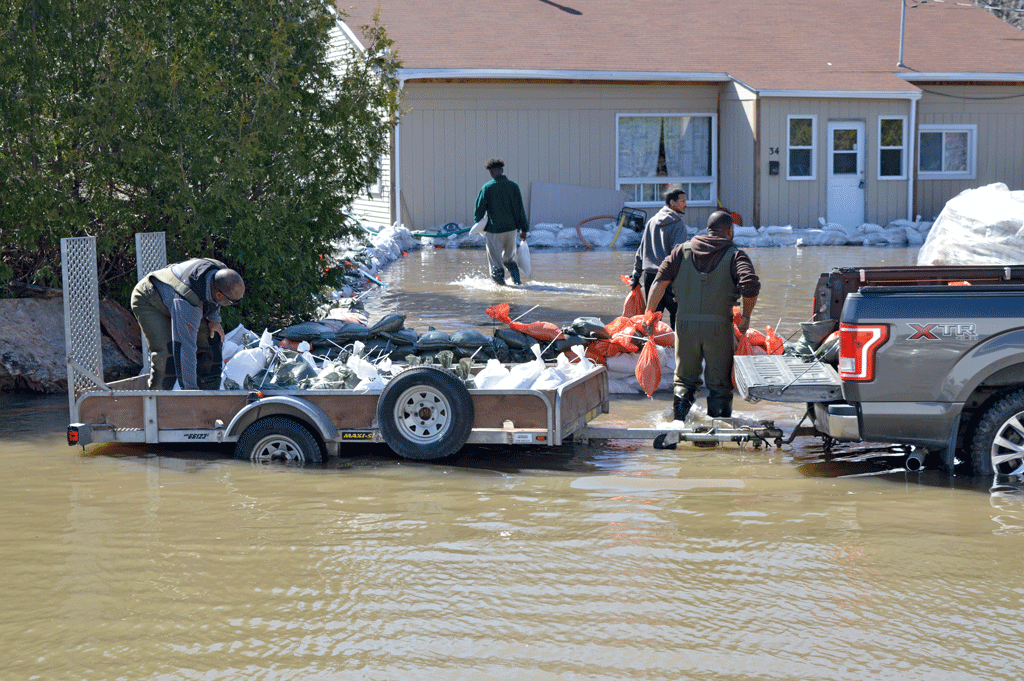
Take the UK, for example. While one study found climate change had increased the risk of floods in England and Wales in Autumn 2000 by at least 20% (and even up to 90%), another found little influence on summer rainfall in 2012 (pdf, p36).
This raises another important point. When it comes to interpreting the results of event attribution studies, it matters what the question is. For example, a 2013 study asked whether recent wet summers in north-western Europe were a response to retreating Arctic sea ice (pdf, p32). The answer from the study was “no”. But, as a foreword from that year’s BAMs report explains:
“Given the numerous ways climate change could influence precipitation in this region, a ‘no’ result for the role of Arctic sea ice should not be interpreted as an absence of any role at all for climate change.”
This is similar to an argument made by Dr Kevin Trenberth, distinguished senior scientist at the National Center for Atmospheric Research, and colleagues in a Nature Climate Change “perspective” article in 2015.
The paper notes that, in a chaotic weather system, the complex dynamics of the atmosphere mean the size and path of a storm or heavy rainfall event has a large element of chance. This can make it tricky to identify where climate change fits in, potentially underestimating its influence.
Therefore, rather than analysing the weather patterns that bring a storm to an area, the authors argue that scientists should be looking at how the impact of that storm has been boosted by temperature changes – known as “thermodynamic” effects. Higher temperatures mean warmer seas, higher sea levels and more moisture evaporating into the atmosphere. These are changes that scientists can be more confident in, the authors wrote, and so should be the focus for attribution studies – rather than looking at changes to circulation patterns in the atmosphere.
For example, the paper reexamines an earlier study (pdf, p15) that suggested climate change had reduced the chances of the five-day heavy rainfall event that hit north-east Colorado in September 2013. Trenberth and colleagues argue that while climate change might not have made the specific weather system that brought the rain more likely, it will have contributed to the sheer volume of moisture in the atmosphere.
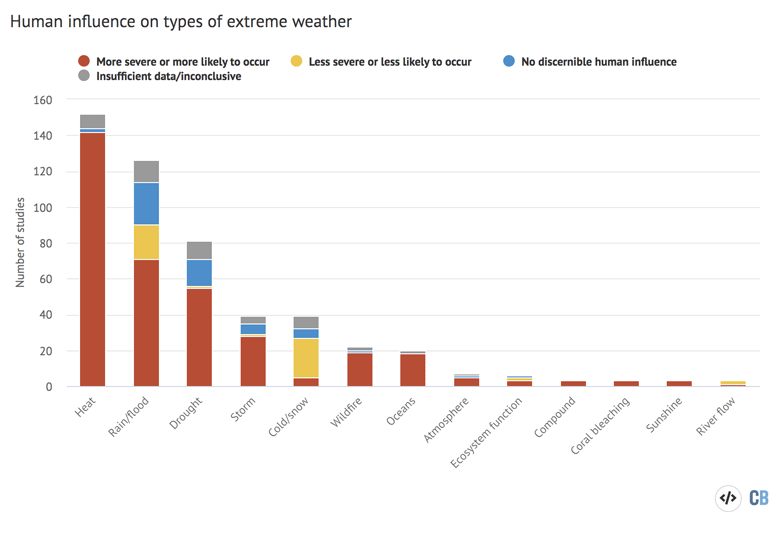
While attribution studies of heatwaves are generally more straightforward than storms – as they focus on thermodynamic influences – the type of question they are asking is still important. The Russian heatwave in 2010 is a good example of this. One study looking at the severity of the event did not find a role for climate change. Yet another one, which did find an influence, looked at the likelihood of the event.
This apparent contradiction is tackled by a third study that reconciles the other two. It explains that “the same event can be both mostly internally-generated [i.e. by natural variability] in terms of magnitude and mostly externally-driven [i.e. by human-caused climate change] in terms of occurrence probability”.
Otto, who is lead author of the third study, tells Carbon Brief:
“The studies, thus, only appear to be contradictory, but are, in fact, complementary.”
It is also important to stress that the absence of evidence for a link to climate change is not the same as evidence of absence. In other words, it does not necessarily mean there was no human influence, just that a particular analysis did not find one. This is why a single study should never be considered the final word on how climate change influences a given type of extreme weather.
Drought
Of the 81 drought events and trends considered here, climate change was found to have increased the severity or likelihood of 55 (68%). Of the remainder, the likelihood or severity was reduced for one event (1%), while no discernible link with human activity was found for 15 (19%) and 10 (12%) were inconclusive.
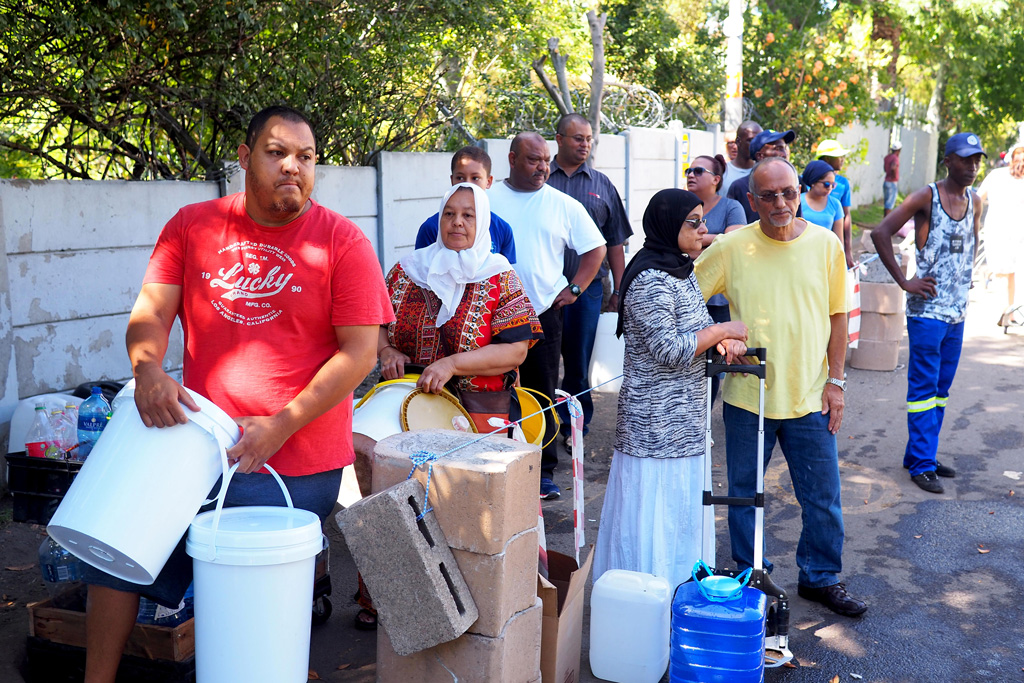
Capetonians queue for water at natural springs around the city during the water crisis, January 2018. Credit: tim wege / Alamy Stock Photo
This mixed bag of results reflects the inherent complexity of droughts. And, again, the specific question matters. Conclusions about the role of climate change in a specific drought could depend on whether a study looks at temperature, rainfall or soil moisture, for example.
As the 2015 BAMS report explains:
“Drought continues to be an event type where the results require significant context, and easy answers often remain elusive because of the many meteorological, hydrological, and societal drivers that combine to cause drought.”
(For more on the different ways that droughts can be categorised, see this Carbon Brief guest post from 2018.)
Geographical reach
While much has been achieved in the field of extreme event attribution in a short space of time, scientists are constantly looking for ways to tailor their work to suit the people who might use it.
One major goal since the early days of the field has been to expand extreme event attribution to cover a larger and more diverse geographical area.
Where in the world scientists can carry out attribution studies – and for what kind of events – will always be limited by the quality and availability of observed data and appropriate models. The attribution map highlights, for example, that there are relatively few studies of extreme weather in Africa and South America.
In another example, scientists hoping to analyse Super Typhoon Mangkhut – which hit the Philippines in September 2018 – were unable to in part because of “very poor quality” observed data in publicly available datasets and a lack of models.
At the moment, there is also a heavy leaning towards weather events that are local to the modelling groups, or that have a particular scientific interest. Otto explains:
“For example, scientists often do attribution studies because an event occurs on their doorstep. The UK, California and Boulder [in Colorado] are, therefore, studied much more than other parts of the world, but that does not necessarily make them places particularly impacted by climate change.”
This means that while the studies carried out so far are indicative of the role climate change is playing in extreme weather around the world, they should not be considered representative of all types of extreme weather everywhere, says Otto. She tells Carbon Brief:
“[The studies so far] are part of a picture, but we don’t know what’s on the missing puzzle pieces. And, crucially, we don’t know how many pieces are missing.”
For example, Otto recently penned a Carbon Brief guest post on how the lack of monitoring of heatwaves in Africa means they are a “forgotten impact” of climate change.
Real-time extreme weather attribution
As well as expanding the science to cover different types of weather and more of the world, scientists are getting faster at turning the handle on extreme event attribution studies – sometimes crunching the numbers just days after an event has occurred.
The rapid studies included here are all produced by the World Weather Attribution (WWA) initiative, described earlier, or the UK Met Office.
An example of analysis performed by the latter includes their review of the UK’s weather in 2020, which was published by Carbon Brief. This showed that climate change increased the likelihood of the UK’s warm year by approximately a factor of 50.
While the WWA individual rapid assessments are not individually peer-reviewed, they are conducted using methods that have been through the peer-review process. As the 2014 BAMS report explains:
“Much like other routine analysis, such as an operational seasonal forecast, statements made about heat events using these methods do not necessarily need to go through the peer-reviewed literature to be considered credible.”
By conducting the analysis in the immediate aftermath of a weather event, these rapid studies provide almost-real-time information on the influence of climate change, rather than having to wait many months for a formal study.
(In some cases, these rapid assessments are later published in peer-reviewed journals. In these instances, the formal study is included in the attribution map, rather than the initial analysis. In some cases, this means earlier rapid assessments are removed from the Carbon Brief map in order to add in the relevant peer-reviewed paper once it is published.)
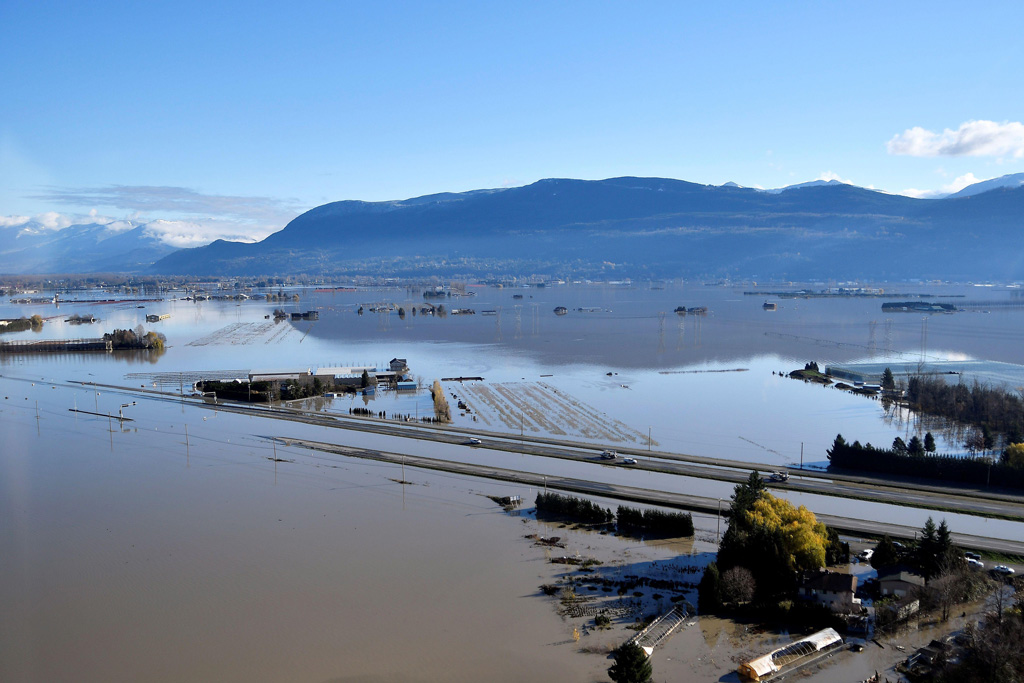
The European Centre for Medium-Range Weather Forecasts (ECMWF) has been working on a pilot “operational attribution service” through the Copernicus Climate Change Service (C3S).
This collaboration between the UK Met Office, German weather service (DWD), Meteo France, Dutch weather service (KNMI) and the University of Oxford will “demonstrate how attribution of extreme weather events can be carried out operationally by national meteorological services”, Prof Stott tells Carbon Brief:
“In this project we are developing and testing the protocols we will need to enable rapid and reliable assessments of the extent to which recent extreme weather events have been made more or less intense or more or less likely by climate change. We started at the beginning of the year and so far we have tested our procedures on an analysis of the 2018 heatwave in Europe.”
The progress to date has “demonstrated the importance of international collaboration for developing new techniques and processes”, says Stott. But “national meteorological services across Europe will continue to have a particular remit to deliver advice on weather and climate in their own countries”, he adds:
“At the Met Office in the UK we are developing our operational attribution capability to help inform the public, policymakers and journalists about the extent to which damaging extreme weather events like the floods in Yorkshire [in 2019] have been affected by climate change.”
An evolving science
As the science of extreme event attribution has matured and become more nuanced, so has the choice of terminology around extreme weather and climate change.
While some attest that all extreme weather must be affected by a world that is warming, this warrants some caution. As the first BAMS report in 2012 noted:
“While it has been argued that in the Anthropocene, all extreme weather or climate events that occur are altered by human influence on climate…this does not mean that climate change can be blamed for every extreme weather or climate event. After all, there has always been extreme weather.”
But while it would be premature to suggest that any single study is the last word, it is clear that – in many cases – the science can do better than that. Similarly, scientific thinking has clearly moved on from the unsatisfactory statement that it is not possible to attribute any individual weather event to climate change. Indeed, as mentioned earlier, there have been some studies that have concluded that an event – or aspect of an event – would have been impossible without climate change.
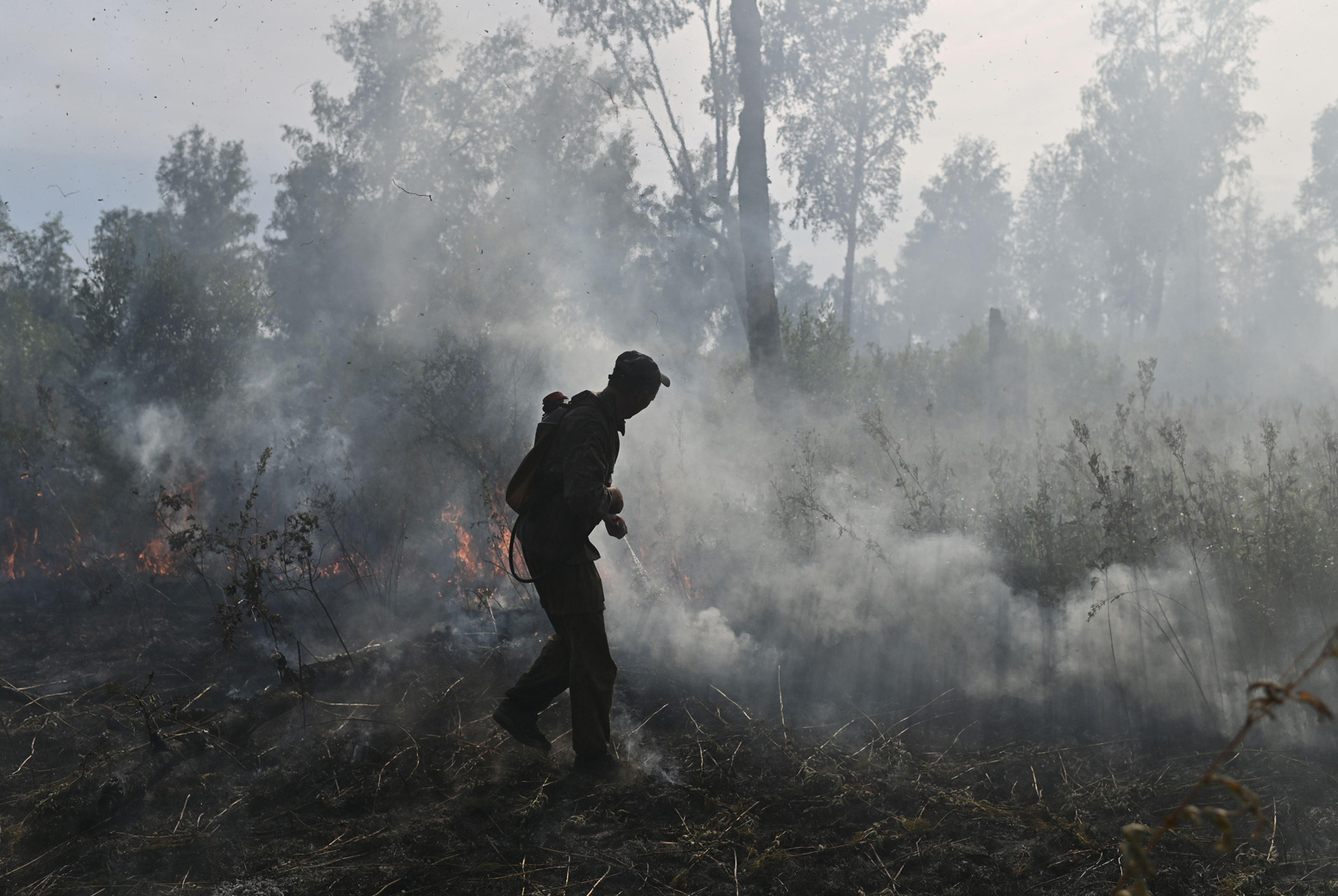
Ultimately, there are no blanket rules in attribution. Scientists need to examine the circumstances of each individual weather event – or a longer pattern of events for trend studies. It is only by combining evidence from all around the world that they can begin to draw broader conclusions.
Attribution studies, therefore, rely heavily on the quality and availability of observational data and climate model simulations. In a short paper for the journal Weather, Dr Otto says that “the models used for attribution need to be able to reliably estimate the likelihoods of the types of events being attributed”.
As discussed earlier, attribution studies of heatwaves tend to be more straightforward because of their focus on thermodynamic effects, rather than atmospheric circulation. Yet, Otto tells Carbon Brief that recent studies suggest models overestimate the year-to-year variability of heat extremes in some parts of the world, and thus underestimate the trend and the role of climate change.
In a rapid attribution study of the western Europe summer heatwave in 2019, for example, Otto and her colleagues found that, for the month of June, the models “show about 50% smaller trends than observations in this part of Europe and much higher year-to-year variability than the observations”. Similarly, a study of the 2019-20 Australian bushfires noted that “models underestimate the observed trend in heat” and so the “real increase could be much higher”.
These findings emphasise how important it is to analyse models and observations together, Otto says:
“This made me realise just how important attribution is for the scientific community – and everyone using climate science – at bringing observations and models together in a very concrete real-world test case.
Attribution can, therefore, be used to help scientists “identify where the models are doing well and for what they are not in a much more direct way than the classical skill assessment of climate projections does”, adds Otto.
Forecasted attribution
One attempt to move attribution science forward was the very first “advance forecasted” attribution analysis, which quantified the impact of climate change on the size, rainfall, and intensity of Hurricane Florence before it made landfall in North Carolina in September 2018.
The analysis ran two sets of short-term forecasts for the hurricane: one as the climate is today and the other in a simulated world without human-caused climate change. The researchers concluded at the time:
“We find that rainfall will be significantly increased by over 50% in the heaviest precipitating parts of the storm. This increase is substantially larger than expected from thermodynamic considerations alone. We further find that the storm will remain at a high category on the Saffir-Simpson scale for a longer duration and that the storm is approximately 80km in diameter larger at landfall because of the human interference in the climate system.”
The analysis received a mixed reaction. Prof Stott told Carbon Brief that it was “quite a cool idea”, but would be dependent on being able to forecast such events reliably. Dr Kevin Trenberth, distinguished senior scientist at the National Center for Atmospheric Research, described it as “a bit of a disaster”. He told Carbon Brief that the quality of the forecast was questionable for the assessment:
“The forecasts made were not good: the intensity of the forecast storm at landfall was category 4 or 5 as I recall, instead of category 2. And so the statements made were based on quite flawed assumptions: namely, that they had a good forecast.”
A key requirement for a reliable attribution study is for models to accurately replicate the extreme event, Trenberth added, but “obviously one can not assess the goodness of the forecast if one does this in advance”.
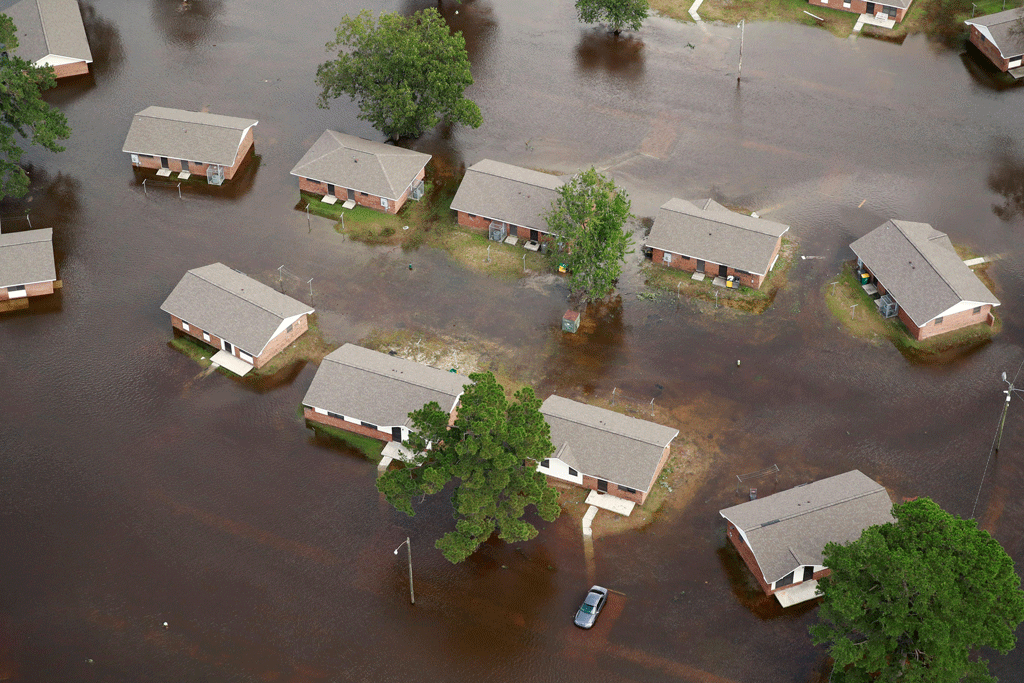
The authors subsequently published a paper in Science Advances that “reviews the forecasted attribution with the benefit of hindsight”. The findings show that climate change increased rainfall amounts “associated with the forecasted storm’s core” by around 5%, and contributed to Hurricane Florence being “about 9km larger in mean maximum diameter (or a 1.6% increase in storm area) due to climate change”.
The authors acknowledged that the “quantitative aspects of our forecasted attribution statements fall outside broad confidence intervals of our hindcasted statements and are quite different from the hindcasted best estimates”. In short, the results are quite a way off what they forecasted.
However, the authors also said they have identified what went wrong with their forecasted analysis. Problems with the way their “without climate change” model runs were set up created a larger contrast against their real-world simulations. The results thus suggested that climate change would have a bigger impact than it actually did.
Nonetheless, the study did identify a quantifiable impact of climate change on Hurricane Florence, adding to the evidence from studies by other author groups, the researchers concluded:
“As the climate continues to warm, it is expected that extreme tropical cyclone precipitation events and resulting inland flooding will become yet more frequent.”
In addition, a 2021 study of the record Australian heat event of October 2015 noted the potential of their methods “to provide attribution statements for forecast events within an outlook period”. This will “allow for informed messaging to be available as required when an extreme event occurs, which is of particular use to weather and climate services”, the authors wrote.
On the topic of forecasts, a 2021 study showed how it was possible to use a weather forecast model for attribution. The researchers, who penned a Carbon Brief guest post about their work, tested their methods using the European heatwave of February 2019 – an event their model successfully predicted:
“We find that the direct impact of the extra carbon dioxide (CO2) that humans have pumped into the atmosphere made the event 42% more likely for the British Isles and at least 100% (two times) more likely for France.”
Their work “so far represents just the first few steps towards an operational forecast-based attribution system”, they noted.
Finally, as well as casting forwards, attribution can also look back in time. A 2020 study on the US “Dust Bowl” heat and drought events of the 1930s takes an unconventional approach of looking at how the past event “would behave” with present-day levels of greenhouse gases.
The researchers find that “the return period of a 1-in-100-year heatwave summer (as observed in 1936) would be reduced to about 1-in-40 years” in today’s climate.
Carbon Brief will continue to add new extreme event attribution studies to the map and update the accompanying analysis every year. Please get in touch with any suggestions of attribution studies that could be included.
This is the fifth iteration of Carbon Brief’s attribution map. The first, second and third and fourth editions, published in July 2017, March 2019, April 2020 and February 2021, respectively, are still available at the archived links included here.
Original interactive map by Rosamund Pearce for Carbon Brief. Revised and updated by Tom Prater and Joe Goodman.
Please note: International borders are determined by the mapping software, not Carbon Brief.
Update: This article was updated on 05/08/2022 to include a mention of a 2015 attribution study of all global heat and heavy rainfall extremes.
